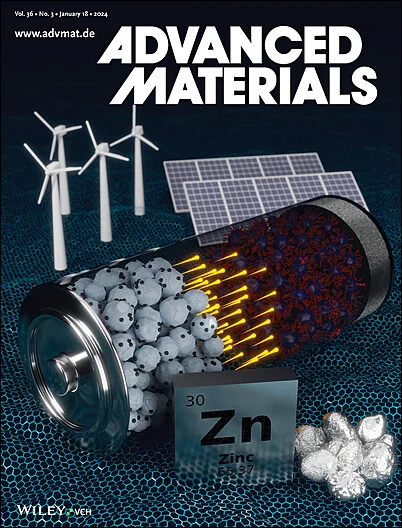一种水膨胀和可降解的生物材料,使生物流体中膜基装置的形状恢复。
IF 26.8
1区 材料科学
Q1 CHEMISTRY, MULTIDISCIPLINARY
引用次数: 0
摘要
吸湿驱动是一种重要的材料功能,它可以实现广泛的应用,如自修复装置,软机器人和导管植入。随着目前可植入设备向柔软和组织模拟系统的转变,由于水掺入后分子间相互作用的迅速丧失,这种功能在柔软和生物材料中特别弱。本研究开发了一种壳聚糖基生物复合材料,通过氢键、塑化和纳米约束的协同作用,在吸水过程中维持分子间的排斥力。当与体液相互作用时,这种材料在其体积膨胀过程中提供稳定而强大的拉伸力。因此,它可以作为一种功能性涂层,使一种基于薄膜的设备自我变平,这种设备保持导管输送所需的管状形状,然后自然降解。这种能力在体内进一步得到证实,使用滚动摩擦电纳米发电机(TENG)进行心内植入。植入心脏左心室后,TENG装置恢复了原来的形状,恢复了正常的能量收集功能,证明了柔性膜基装置微创植入的可行性。本文章由计算机程序翻译,如有差异,请以英文原文为准。
A Hydro-Expansive and Degradable Biomaterial Enabling Shape Recovery of Film-Based Devices in Biofluids.
Hygroscopic actuation is an important material function, which enables a broad range of applications such as self-healing devices, soft robotics, and catheter implantation. With the current paradigm of implantable devices shifting toward soft and tissue-mimicking systems, this function however, is particularly weak in soft- and bio-materials due to the rapid loss of intermolecular interactions upon water incorporation. Here, a chitosan-based bio-composite is developed, which sustains the intermolecular repulsive force during water absorption through synergistic effects of hydrogen bonding, plasticization, and nano-confinement. When interact with body fluids, this material provides a stable and strong tensile force throughout its volume expansion process. Therefore, it serves as a functional coating that self-flattens a thin film-based device which holds a tubular shape needed for catheter delivery, and then degrades naturally. This capability is further demonstrated in vivo using a rolled triboelectric nanogenerator (TENG) for intracardiac implantation. The TENG device recovers its original shape after being placed inside the heart left ventricle and restores its regular energy harvesting function, evidencing the feasibility for minimally invasive implantation of flexible film-based devices.
求助全文
通过发布文献求助,成功后即可免费获取论文全文。
去求助
来源期刊

Advanced Materials
工程技术-材料科学:综合
CiteScore
43.00
自引率
4.10%
发文量
2182
审稿时长
2 months
期刊介绍:
Advanced Materials, one of the world's most prestigious journals and the foundation of the Advanced portfolio, is the home of choice for best-in-class materials science for more than 30 years. Following this fast-growing and interdisciplinary field, we are considering and publishing the most important discoveries on any and all materials from materials scientists, chemists, physicists, engineers as well as health and life scientists and bringing you the latest results and trends in modern materials-related research every week.
 求助内容:
求助内容: 应助结果提醒方式:
应助结果提醒方式:


